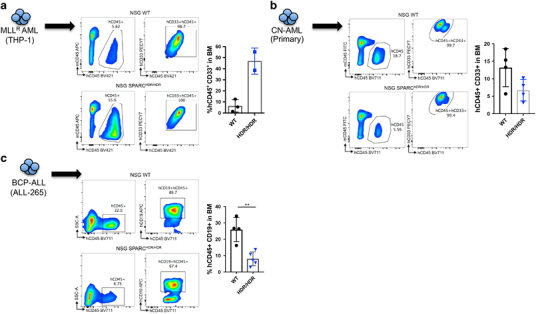Figure 2.

NSG SPARC mice reveal opposing effects of niche-derived SPARC in human leukemia. Percentage and immunophenotyping of hCD45+ cells in the bone marrow of WT and SPARCHDR/HDR mice engrafted with 106 MLL-AF9-expressing THP-1 cells (WT NSG n=3; SPARC KO n=2) analyzed 5 weeks post transplant (a), 106 cells from a cytogenetically normal (CN) primary AML case (WT NSG n=4; SPARC KO n=4) analyzed 11 weeks post transplant (b) or 105 cells from a BCP-ALL relapsed case (ALL-265; WT NSG n=4; SPARC KO n=5) analyzed 5 weeks post transplant (c). The data show a significantly increased leukemic burden in SPARCHDR/HDR mice receiving THP-1 cells (a). In stark contrast, leukemic burden is dramatically decreased in SPARCHDR/HDR mice receiving the primary CN-AML case or the relapsed BCP-ALL case (ALL-265) (b, c). Of note, additional THP-1 and BCP-ALL cases (ALL-199) are depicted in supplementary Figures 7 and 8. Each dot represents an independent mouse. Unpaired Student’s t-test, **P<0.01.
